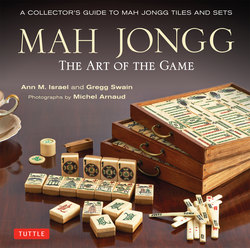Читать книгу Mah Jongg: The Art of the Game - Gregg Swain - Страница 6
На сайте Литреса книга снята с продажи.
Оглавление| Foreword A Smoke-filled Room |
My mother had me late in life, giving me the unique advantage of spending many hours of my childhood with middle-aged Jewish women. Being dragged along with my mother on her day off so we could inhale second-hand smoke, listen to juicy gossip, and eat tuna salad sandwiches had a huge impact on my life.
Working full-time did not stop Mother from playing in two weekly Mah Jongg games. Her Tuesday evening group was the best. They spent less time playing and more time kibbitzing. They would become the basis of every female character in my books. Soon after the game began, the room would fill with smoke. I always remarked that it looked like Los Angeles at sunset, and my mother’s orange shag carpet and yellow sofas did little to dispel that image.
Of all the women in the room, only two were originally from Newport News, Virginia. One was from the Bronx, the other from Brooklyn, and my mother from Washington, DC. Had it not been for this loud, tile-clacking game, these women would never have met, nor would they have become such close friends. As the story goes, Mah Jongg was being played every Tuesday evening for as long as any of them could remember. If a player moved, another was invited to play, and if a player died, someone’s daughter joined the group. To this day, the game is still being played on Tuesday evenings.
The tiles my mother used—a Bakelite set—belonged to her mother. Some were faded and the case was frayed, but that set was in continuous use for almost ninety years. Nana passed it on to my mother, and when my mother died, the first thing I took from the house was Mother’s Mah Jongg set. That set had more meaning to me than even her costume jewelry. I used that set for a few years until someone pointed out that one of the four Craks and two of the Jokers were a different shade from the rest of the tiles. As I did not want to be accused of cheating, I bought my own set. But I will never give away Nana and Mother’s faded yellow Bakelite Mah Jongg set, which witnessed who knows how many engagements, weddings, b’ris ceremonies, bar mitzvahs, divorces, and funerals. And while fashions changed, those tiles never went out of style.
I have even considered having a Mah Jongg table top made out of the tiles. That way, even when I play with my set, I will still be playing with the tiles that brought together the women who influenced me the most. Sadly, all but one of those women have died, but I will never forget walking into that smoke-filled room and seeing all those overly made up faces with their teased hair and the endless cigarettes. It was an experience I would not trade for the world.
I am happy to see Ann and Gregg bring together so many fascinating sets of Mah Jongg tiles and ephemera. I am sure Mother and her crowd would have loved the beautiful ivory sets and been amazed at the black bamboo set. This book is not just for collectors or players but for everyone interested in history and art.
Mah Jongg brought Mother and her friends together and kept them together for fifty years. Without this wonderful game, I don’t know what I would have become. Maybe a doctor? It was your fault, Mother!
Milton Stern
Left Sung San Chai’s boxes included dividers for counters.
